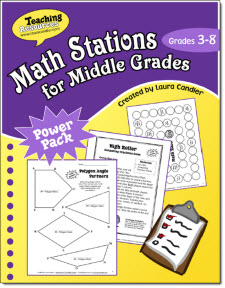I started math centers as an elementary teacher and when I moved to middle school, I really wanted to use them. I couldn't figure out the logistics though. So many kids, big bodies, and short classes.
The biggest problem was behavior for me. Plus, students aren't always on task.
I have tried several methods. I like them all and I use them as I see fit.
1. Multiple stations, Students stay in one spot.
With so many bodies in one room, this worked well. We gave each group six activities. Students chose which to do first, but they had to do all six, any order.
First time, tough... Kids needed a lot of support, but semi success.
Wish I had taken a picture of this. We had 6 cards, different colors, clipped together by a silver ring. We made 6 sets for each group. (can you visualize this?)
2. Quick stations, cut worksheet apart. I posted on this here, and the original idea came from I Speak Math of course!
I hate worksheets as much as students do. I have done this a lot and seen this on many blogs.Cut a worksheet apart, copy on bright apart and viola you have instant centers. I love because students work and then check their work.
I like this because it is fast to prepare.
3. Weekly stations: I have used this in my small, math lab classes. I have 4 stations for the week, students go to one a day. These are mostly game formatted. This worked well, but sometimes not enough work to keep kids on task. Best resource EVER from Laura Candler.

This is a picture of my center rotation pocket chart. The orange cards are the stations, the green cards have the students names on them. Each day I rotated the green cards. Students knew where they were going each day and what was coming next. It was simple for one group of kids.
4. Rotations: I did a learning walk through a Language Arts class and she had 5 or 6 rotations, students worked on maybe two a day, twenty minute rotations, the teacher I observed had obviously trained her kids. They knew what to do and actually did it. (They were eighth grade).
So I tried it. We needed six rotations with our class sizes. We had one rotation computers, one iPads, one was a teacher table and the others were designed for students to work independently. Those were the least successful. We have 50 minute classes, with warm up and homework review, rotations were not 20 minutes...
I hung the rotation cards up, but also had a copy in each basket. Each basket had everything they would need to complete the rotation. Students stayed in their groups, basket rotated.
Semi successful, but not my favorite.
I recently tried a second round of rotations and it was nightmarish. I abandoned ship and we completed the activities much differently. Some classes worked independently, some worked in pairs. It depended on the dynamics of each class. I think there was a full moon that week!
I gotta say, I like stations, rotations and centers, no matter what they are called. I like kids working together. I like kids practicing math concepts.
I wish I had one way that worked, but that is not reality.
So, I do what fits the lesson, my students, and of course what I can handle without becoming an alcoholic!
I have so much I want to improve in this area. I know there is so much out there and so many good ideas to explore.
Can't wait to see other ways middle school teachers use stations, rotations or centers.





I'm wanting to try small group/stations with my 6th graders who are all below level. I'm thinking maybe give them a checklist (not really rotate) that they have to finish by the end of the math period. So I would teach a whole group lesson and then they would have a practice sheet, computer practice, and....and.... :) Not sure what else-I don't really want to be making anything every week at this point because I am self-contained and teaching ALL subjects this year so I'm a little overwhelmed. :)
ReplyDeleteAny ideas?
Shannon
http://www.irunreadteach.wordpress.com